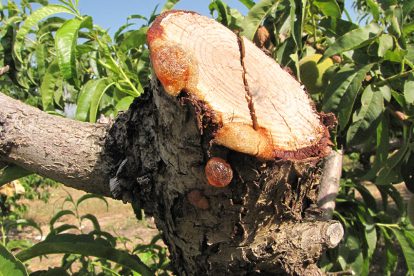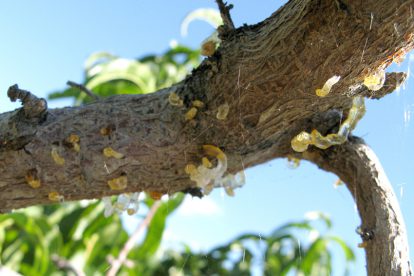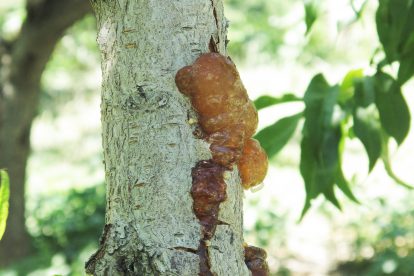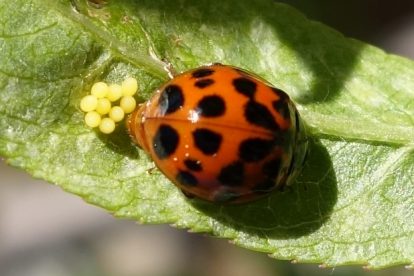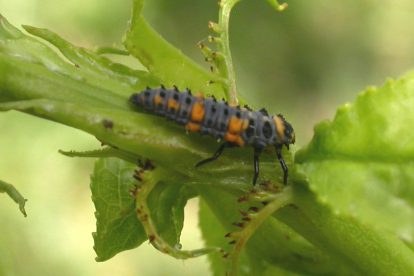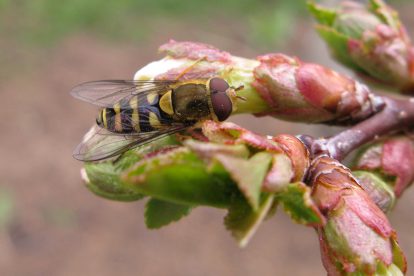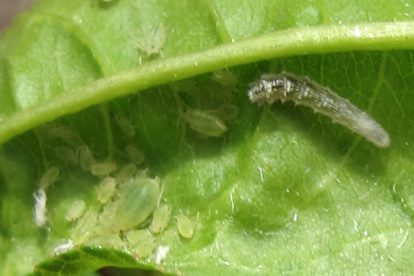In this Issue:
- Apple, Pear: codling moth and powdery mildew
- Peach/Nectarine, Apricot, Plum: gummosis (cytospora canker), peach twig borer
- Two beneficials to look for now: lady beetles, syrphid fly
APPLE, PEAR
Codling Moth
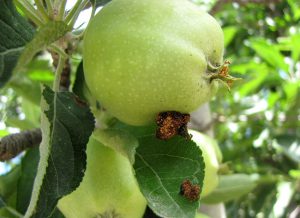
Soon, we will know the timing for starting treatment in northern Utah, but we have not yet caught codling moths in our traps there, yet. Based on information from last year, the starting time will be close to May 20 for the warmest areas of northern Utah. But now is the time to prepare. The table below lists some options to use, depending on how you manage your trees.
Codling Moth Treatment Notes for Residential Trees
| Situation | Example Materials | Damage Last Year | Notes on Treatment Program |
|---|---|---|---|
| Organic-residential | Cyd-X, Bt products (Captain Jacks), pyrethrin (Fertilome Fruit Tree) spinosad (Green Light, Monterey), neem oil | high | Apply first application at “start date.” Repeat 7-10 days later for a total of 3 applications in the first generation. When the “start date” for the 2nd generation is provided, spray every 7-10 days until Sept. 15. Pick a different product to use for each generation. |
| low | Apply first application at “start date.” When the “start date” for the 2nd generation is provided, spray every 10-14 days until Sept. 15. Pick a different product to use for each generation. | ||
| Conventional-residential | Ortho Fruit & Veg (acetamiprid), Spectracide Triazicide (lambda-cy), Malathion, Sevin | high | Apply first application at “start date.” Repeat 14 days later for a total of 2 applications in the first generation. When the “start date” for the 2nd generation is provided, spray every 10-18 days until Sept. 15. Pick a different product to use for each generation. |
| low | Apply an application at “start date.” Wait until the “start date” for the 2nd generation is provided, and spray on that date, and again 14 days later. Do the same for the 3rd generation. Pick a different product to use for each generation. |
Codling Moth Treatment Notes for Commercial Orchards
| Situation | Example Materials | Damage Last Year | Notes on Treatment Program |
|---|---|---|---|
| Organic - Commercial | Cyd-X, Dipel, Entrust, horticultural oil, azadirachtin products | high | Treatments should be applied every 5-7 days throughout each generation. Use a different product for each (entire) generation. Use virus in the 1st and 3rd generations. |
| low | Apply oil at recommended timing (200 DD). Apply “delayed” first cover at recommended timing, and repeat 7 days later. For 2nd and 3rd generations, apply 2 covers in each, one at the start of egg hatch, and one during the period of greatest egg hatch (dates to be provided). | ||
| mating disruption | Apply first cover on entire orchard at start of egg hatch. Use traps to determine when to treat again (7-10 moths/week). | ||
| Conventional - commercial | pyrethroids, Imidan, Altacor, Delegate, Belt, Leverage | high | Spray at start of egg hatch. Repeat during period of greatest egg hatch (dates provided). For 2nd and 3rd generations, apply every 14-21 days (depending on material). Use a different product for each generation. |
| low | Apply oil at recommended timing (200 DD). Apply “delayed” first cover at recommended timing (350 DD). For 2nd and 3rd generations, apply once at the beginning of the generation. For 3rd generation, apply again at the recommended timing of greatest egg hatch. | ||
| mating disruption | Apply first cover as border spray. Watch pheromone traps (catches of 7-10/week) to determine supplemental treatments. |
Apple Powdery Mildew
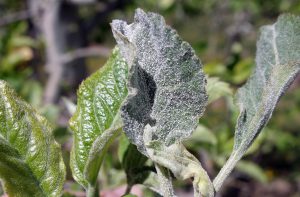
If present, powdery mildew will start spreading quickly now, and continue to spread so long as conditions are humid in the tree canopy. The humidity can rise just enough for spread on overcast days, especially if the tree canopy is dense. Later in the season, irrigation causes increased humidity.
The fungus that causes apple powdery mildew overwinters on twigs, so this is why new infections happen almost as soon as leaves emerge. Cortland, Idared, Gingergold, Braeburn, Gala, and Jonagold are all varieties that are more susceptible.
Commercial growers: most should have applied a treatment or two by now. If needed, options are shown by clicking here.
Residential growers can use:
- Spectracide Immunox: apply every 14 days as needed
- Wettable sulfur (organic; many brands): apply every 10 days as needed
- Neem oil or 1% horticultural oil (organic; many brands): apply every 3 to 5 days as needed, but not when temperatures will reach 85F within 4 hours of application
- Potassium bicarbonate (organic; Monterey Bi-Carb, Garden-Ville): apply every 7 days as needed
PEACH/NECTARINE, APRICOT, PLUM
Cytospora canker
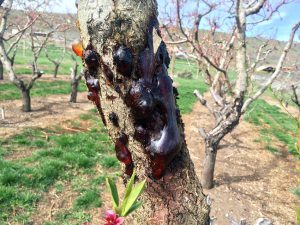
Every spring, one of the most common questions I get is regarding gumming on stone fruits (peach, apricot, plum). The oozing is generically referred to as gummosis and it can be clear or dark amber in color. By the end of the summer, it will have become almost rock-hard.
The most common cause of gumming is a disease called cytospora canker. It is caused by a fungus (Leucostoma cincta) that must infect bark through an existing wound such as pruning cuts, sun scald, winter injury, hail, etc. It kills the bark and cambium, and the tree oozes gum as a defensive measure. Gumming from cytospora is dark amber in color, and if you scrape the bark off, the dead phloem will appear cinnamon brown in color. Cytospora canker is very common in Utah’s peach and apricot orchards, as well as on backyard trees.
Prevention is the key to managing Cytospora
- In normal pruning operations, make proper cuts (i.e., do not leave stubs or do not make “flat cuts” that remove the branch collar where healing would normally occur) and do not prune in wet weather. Pruning the Orchard
- Protect the bark during winter from sun scald. Either apply white tree wrap from December to March, or paint the trunk (anytime) with 50/50 latex paint/water;
- Prune out infected limbs and twigs back to healthy wood, and sterilize tools with 10% bleach or Lysol wipes between cuts. Sometimes it is not possible to remove all infected limbs. In that case, be diligent about tree health, sanitation, and regular pruning practices.
- Remove severely affected trees from the orchard.
- Keep trees healthy with optimal watering, mulching, nutrition, etc.
- An excellent bulletin on Cytospora of fruit trees was written by Colorado State University.
Other Causes of Gumming
- Thick gumming at the base of the tree (no higher than 8-12”): Greater peachtree borer. Trees can be protected with a properly timed insecticide, typically in late June (we will include dates in a future advisory).
- Small areas of ooze, throughout the tree: Borers. Flatheaded or shothole borers will only attack weakened trees or wounds such as where sunscald has occurred. Usually there is very little ooze associated with these insects because the trees are already weakened. If the borers attack healthy trees, however, the tree will exude copious sap/ooze to flush out the larvae. This ooze is often clear in color, and limited to beetle entry holes. Management of these pests is difficult, and may include bark sprays of permethrin May through August.
- Random pattern of gumming: Wounds or other cause. Gummosis not caused by a pathogen will run somewhat clear in color (but will dry to amber). Wounds include frost cracks or sun scald, bark injury, cat scratching, hail, etc. Other causes include planting too deep, excessive irrigation, severe summer pruning, or over-bearing.
If you are not sure that a pathogen is causing the gummosis, scrape the outer bark away. If the inner bark is still cream-colored (healthy), the oozing is caused by a non-living factor, and there is nothing you should do. If the wood is tan to brown, it is dead, and was most likely killed by a pathogen.

Peach Twig Borer
Info for commercial growers only:
- If you are using the Isomate brand of mating disruption for PTB, dispensers can be hung any time.
- Hang pheromone monitoring traps now to get biofix
Beneficials to Look For Now
Aphid activity on fruit trees is starting now, and two important aphid predators are among the first to be seen in spring: lady beetles and syrphid flies (also known as hover flies). Protect them by examining aphid-infested areas for these beneficials, and wait to spray if they are present.

